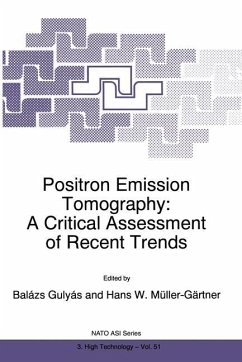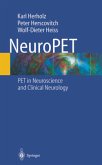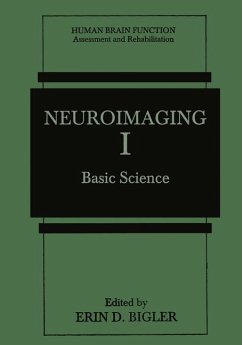Positron Emission Tomography
A Critical Assessment of Recent Trends
Herausgegeben:Gulyás, Balázs; Müller-Gärtner, Hans W.
Positron Emission Tomography
A Critical Assessment of Recent Trends
Herausgegeben:Gulyás, Balázs; Müller-Gärtner, Hans W.
- Broschiertes Buch
- Merkliste
- Auf die Merkliste
- Bewerten Bewerten
- Teilen
- Produkt teilen
- Produkterinnerung
- Produkterinnerung
A critical summary of the state of the art of PET technology and related disciplines (camera physics, radiochemistry, radiopharmacology, computerised brain atlases and databases, etc.), plus a survey of the most recent developments in the clinical and neuroscience applications of PET. The chapters systematically guide the reader from the basics of the technique - including new camera designs, new drugs, and new statistical and image processing approaches - through its most important clinical applications - in neurology, psychiatry and oncology - to the most sophisticated neuroscience…mehr
Andere Kunden interessierten sich auch für
![NeuroPET NeuroPET]() K. HerholzNeuroPET38,99 €
K. HerholzNeuroPET38,99 €![From Neuron to Action From Neuron to Action]() From Neuron to Action39,99 €
From Neuron to Action39,99 €![Neuroimaging I Neuroimaging I]() Neuroimaging I153,99 €
Neuroimaging I153,99 €![Texture of the Nervous System of Man and the Vertebrates Texture of the Nervous System of Man and the Vertebrates]() Santiago R.y CajalTexture of the Nervous System of Man and the Vertebrates246,99 €
Santiago R.y CajalTexture of the Nervous System of Man and the Vertebrates246,99 €![Texture of the Nervous System of Man and the Vertebrates Texture of the Nervous System of Man and the Vertebrates]() Santiago R.y CajalTexture of the Nervous System of Man and the Vertebrates260,99 €
Santiago R.y CajalTexture of the Nervous System of Man and the Vertebrates260,99 €![Aspiration Cytology in the Staging of Urological Cancer Aspiration Cytology in the Staging of Urological Cancer]() Aspiration Cytology in the Staging of Urological Cancer39,99 €
Aspiration Cytology in the Staging of Urological Cancer39,99 €![Molecular Imaging Molecular Imaging]() Molecular Imaging149,99 €
Molecular Imaging149,99 €-
-
-
A critical summary of the state of the art of PET technology and related disciplines (camera physics, radiochemistry, radiopharmacology, computerised brain atlases and databases, etc.), plus a survey of the most recent developments in the clinical and neuroscience applications of PET.
The chapters systematically guide the reader from the basics of the technique - including new camera designs, new drugs, and new statistical and image processing approaches - through its most important clinical applications - in neurology, psychiatry and oncology - to the most sophisticated neuroscience applications, including research into human sensory and motor systems, the functional organisation of imagery, volition, attention and consciousness in the human brain.
The chapters systematically guide the reader from the basics of the technique - including new camera designs, new drugs, and new statistical and image processing approaches - through its most important clinical applications - in neurology, psychiatry and oncology - to the most sophisticated neuroscience applications, including research into human sensory and motor systems, the functional organisation of imagery, volition, attention and consciousness in the human brain.
Produktdetails
- Produktdetails
- Nato Science Partnership Subseries: 3 51
- Verlag: Springer / Springer Netherlands
- Artikelnr. des Verlages: 978-94-010-6097-4
- Softcover reprint of the original 1st edition 1998
- Seitenzahl: 496
- Erscheinungstermin: 14. Oktober 2012
- Englisch
- Abmessung: 240mm x 160mm x 27mm
- Gewicht: 785g
- ISBN-13: 9789401060974
- ISBN-10: 9401060975
- Artikelnr.: 39915881
- Herstellerkennzeichnung
- Springer-Verlag GmbH
- Tiergartenstr. 17
- 69121 Heidelberg
- ProductSafety@springernature.com
- Nato Science Partnership Subseries: 3 51
- Verlag: Springer / Springer Netherlands
- Artikelnr. des Verlages: 978-94-010-6097-4
- Softcover reprint of the original 1st edition 1998
- Seitenzahl: 496
- Erscheinungstermin: 14. Oktober 2012
- Englisch
- Abmessung: 240mm x 160mm x 27mm
- Gewicht: 785g
- ISBN-13: 9789401060974
- ISBN-10: 9401060975
- Artikelnr.: 39915881
- Herstellerkennzeichnung
- Springer-Verlag GmbH
- Tiergartenstr. 17
- 69121 Heidelberg
- ProductSafety@springernature.com
one: How to establish and run a PET Center?.- 1. Planning a proposal for a PET centre.- 2. The use and registration of PET radiopharmaceuticals. European and world trends.- 3. FDG distribution - a new market trend.- 4. Status of clinical PET in the USA and the role and activities of the Institute for Clinical PET.- two: PET: Novel methodological approaches.- 5. Recent trends in PET camera designs.- 6. Strategies for radioligand development: Peptides for tumor targeting.- 7. Development of PET radioligands for the quantitation of serotonin receptors in the human brain.- 8. The renin-angiotensin system.- 9. Membrane transporters.- 10. A deformable high resolution anatomic reference for PET activation studies.- 11. Registration: a powerful tool to combine information provided by different imaging modalities.- 12. Quantification of FDG uptake using kinetic models.- 13. Cavinton affects the kinetic constants of FDG accumulation: an application of registration and kinetic modeling.- 14. Whole body scanning.- three: PET in oncology.- 15. Positron emission tomography in oncology. In vivo measurements of protein synthesis in tumors.- 16. Diagnosis, differential diagnosis, and follow-up of tumors by means of FDG PET.- 17. Clinical application of whole-body [18]-FDG-PET in malignant melanoma.- 18. Evaluation of metastatic lymph nodes by means of FDG PET.- 19. Diagnosis, differential diagnosis, and follow-up of intracranial tumors with PET.- four: PET in neurology and psychiatry.- 20. PET studies in neuropharmacology. Novel approaches.- 21. PET studies of the dopamine hypotheses in schizophrenia.- 22. PET and epilepsy in adults.- 23. Mapping cerebral responses to volatile anesthetics in humans.- 24. The effect of a single-dose intravenous vinpocetine on chronic 291 stroke patients.A PET study.- 25. Coupling between cerebral blood flow and metabolism in the primate: methodological and pharmacological issues.- five: PET in neuroscience research.- 26. BrainMapTM: Electronic integration of mind and brain.- 27. Designing activation experiments.- 28. The human motor system: principles versus plasticity.- 29. Activation of the visual ventral stream in humans: an fMRI study.- 30. PET and fMRI studies of cerebellar function in sensation, perception, and cognition.- 31. How to use neuroimaging to study visual attention.- 32. Characterising selective attention with positron emission tomography. Neurophysiological investigations.- six: Appendix.- 33. PET centers and PET projects in Central and Eastern Europe.- 34. PET Centres around the world.- 35. List of contributors.- 36. Index.- 37. Color plates.
one: How to establish and run a PET Center?.- 1. Planning a proposal for a PET centre.- 2. The use and registration of PET radiopharmaceuticals. European and world trends.- 3. FDG distribution - a new market trend.- 4. Status of clinical PET in the USA and the role and activities of the Institute for Clinical PET.- two: PET: Novel methodological approaches.- 5. Recent trends in PET camera designs.- 6. Strategies for radioligand development: Peptides for tumor targeting.- 7. Development of PET radioligands for the quantitation of serotonin receptors in the human brain.- 8. The renin-angiotensin system.- 9. Membrane transporters.- 10. A deformable high resolution anatomic reference for PET activation studies.- 11. Registration: a powerful tool to combine information provided by different imaging modalities.- 12. Quantification of FDG uptake using kinetic models.- 13. Cavinton affects the kinetic constants of FDG accumulation: an application of registration and kinetic modeling.- 14. Whole body scanning.- three: PET in oncology.- 15. Positron emission tomography in oncology. In vivo measurements of protein synthesis in tumors.- 16. Diagnosis, differential diagnosis, and follow-up of tumors by means of FDG PET.- 17. Clinical application of whole-body [18]-FDG-PET in malignant melanoma.- 18. Evaluation of metastatic lymph nodes by means of FDG PET.- 19. Diagnosis, differential diagnosis, and follow-up of intracranial tumors with PET.- four: PET in neurology and psychiatry.- 20. PET studies in neuropharmacology. Novel approaches.- 21. PET studies of the dopamine hypotheses in schizophrenia.- 22. PET and epilepsy in adults.- 23. Mapping cerebral responses to volatile anesthetics in humans.- 24. The effect of a single-dose intravenous vinpocetine on chronic 291 stroke patients.A PET study.- 25. Coupling between cerebral blood flow and metabolism in the primate: methodological and pharmacological issues.- five: PET in neuroscience research.- 26. BrainMapTM: Electronic integration of mind and brain.- 27. Designing activation experiments.- 28. The human motor system: principles versus plasticity.- 29. Activation of the visual ventral stream in humans: an fMRI study.- 30. PET and fMRI studies of cerebellar function in sensation, perception, and cognition.- 31. How to use neuroimaging to study visual attention.- 32. Characterising selective attention with positron emission tomography. Neurophysiological investigations.- six: Appendix.- 33. PET centers and PET projects in Central and Eastern Europe.- 34. PET Centres around the world.- 35. List of contributors.- 36. Index.- 37. Color plates.








